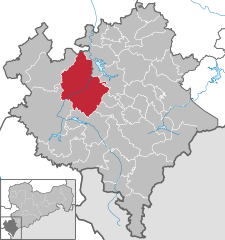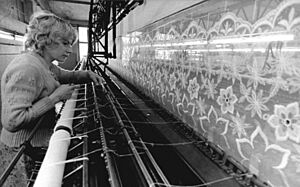Plauen facts for kids
Quick facts for kids
Plauen
|
||
|---|---|---|
|
Clockwise from top: view over the city centre, astronomical clock, St John's Church, old market, St Mark's Church, old and new city hall
|
||
|
||
|
Location of Plauen within Vogtlandkreis district
 |
||
| Lua error in Module:Location_map at line 530: Unable to find the specified location map definition: "Module:Location map/data/Germany Sachsen" does not exist. | ||
| Country | Germany | |
| State | Saxony | |
| District | Vogtlandkreis | |
| Subdivisions | 5 city boroughs with 38 parts | |
| Area | ||
| • Total | 102.11 km2 (39.42 sq mi) | |
| Elevation | 412 m (1,352 ft) | |
| Population
(2022-12-31)
|
||
| • Total | 64,763 | |
| • Density | 634.25/km2 (1,642.69/sq mi) | |
| Time zone | UTC+01:00 (CET) | |
| • Summer (DST) | UTC+02:00 (CEST) | |
| Postal codes |
08523;-5;-7;-9
|
|
| Dialling codes | 03741 | |
| Vehicle registration | V, AE, OVL, PL, RC | |
Plauen (pronounced PLOW-en) is a city in Saxony, Germany. It's the fifth-largest city in Saxony, with about 65,000 people living there. Plauen is also the biggest city in the Saxon Vogtland region.
The city is located on the White Elster river, which is a branch of the Saale river. Plauen is in a hilly area and is the most southwestern city in a line of cities that stretches from Plauen to Dresden. It is the main city of the Vogtland District. Plauen is close to the borders of Thuringia, Bavaria, and the Czech Republic.
Even though Plauen is in Saxony, the local way of speaking (called Vogtlandian) is similar to dialects spoken in nearby Bavaria. The name Plauen and many of its neighborhoods come from Slavic languages. Plauen and the surrounding Saxon Vogtland are famous for making embroidery and lace, especially a type called Plauen lace.
Contents
History of Plauen
Plauen was started by Polabian Slavs in the 1100s. It was first called "Plawe." In 1327, it became part of the Kingdom of Bohemia, which was a powerful area in Central Europe. Later, in 1466, Plauen joined Albertine Saxony, and then in 1569, it became part of the Electorate of Saxony. This was a state within the Holy Roman Empire.
During the Napoleonic Wars in 1806, Plauen became part of the Kingdom of Saxony. In 1871, it joined the new German Empire.
Plauen's Growth and Challenges
In the late 1800s, Plauen became a big center for making textiles, especially the famous Plauen lace. Around 1910, Plauen was a very busy industrial city and had its largest population ever, with over 120,000 people. However, after World War II, the population dropped a lot.
In the 1930s, Plauen had one of the first groups of the Nazi Party outside of Bavaria. During World War II, the Nazis used a prison in Plauen and also had three smaller camps connected to the Flossenbürg concentration camp. Many women, mostly from Poland, Russia, and other countries, were forced to work there. Some men were also held in another camp.
American soldiers took over Plauen on April 16, 1945. But on July 1, 1945, the city was given to the Red Army (Soviet Union). After the war, Plauen was in the Soviet occupation zone, which later became East Germany (also known as the German Democratic Republic or GDR) from 1949 to 1990.
Plauen was home to a large Soviet army base. In 1989, the first big protest against the communist government in East Germany started in Plauen on October 7. This protest helped lead to many more across the country and eventually to Germany becoming one country again in 1990.
After the Berlin Wall fell, Plauen was the first city in East Germany to get a McDonald's restaurant! In 2008, Plauen changed its local government status and became part of the Vogtlandkreis district.
Jewish Community of Plauen
The Jewish community in Plauen started in the early 1300s. Before World War II, several hundred Jewish people lived in the city. A new, modern synagogue was built in 1930. Sadly, it was destroyed in 1938 during an event called Kristallnacht. This was a terrible night when Jewish businesses and synagogues were attacked across Germany.
Because Plauen became a stronghold for the Nazis, Jewish people faced many attacks in the 1920s and 1930s. Most of the Jewish population either left Plauen or were killed during The Holocaust, a terrible time when millions of Jewish people were murdered.
Today, there is no Jewish community in Plauen. However, the city remembers its past Jewish life. They maintain places like the Jewish Cemetery to honor those who lived there. A 3D model of the old synagogue was even created by a team from TU Darmstadt, helping people see what it looked like before it was destroyed.
Industry and Infrastructure
Plauen is an important place for travel. The main train station, called Plauen (Vogtland) Oberer Bahnhof, is on the line connecting Leipzig and Hof. This line is part of a bigger route that goes through Nuremberg, Hof, Plauen, Zwickau, Chemnitz, and Dresden. There was another station, but it's not used anymore. There are plans to rename the main station to Plauen Hauptbahnhof (Main Station).
The Vogtlandbahn (Vogtland Railway) is a train company that runs services from Plauen to many places in Germany, like Hof, Werdau, Chemnitz, Zwickau, Falkenstein, and Adorf. It also goes to Cheb in the Czech Republic. From these stations, you can connect to other Vogtlandbahn trains to cities like Munich, Regensburg, Dresden, Leipzig, Karlovy Vary, and Prague. There's also a Vogtlandbahn Express Bus that goes from Plauen to Berlin's airports and the Zoological Garden.
Plauen also has its own tram system, called the Plauen Straßenbahn. It has 6 lines that connect the city center, including the central Plauen-Tunnel stop, to the surrounding areas and the main train station.
Main Sights
Plauen has many interesting places to visit:
- Embroidery Machine Museum
- Museum Plauener Spitze (Plauen Lace Museum)
- Galerie e.O. plauen (an art gallery)
- Old City Hall
- Elster Viaduct – the second-largest brick bridge in the world!
- Friedensbrücke – the largest stone arch bridge in the world
- Johanniskirche (St. John's Church)
- Old Elster Viaduct – the oldest bridge in Saxony
- Malzhaus (a cultural center)
Education and Science
Plauen is home to a University of Applied Sciences where students can learn practical skills. There is also a DIPLOMA Fachhochschule in the city.
Twin Towns – Sister Cities
Plauen has special friendships with other cities around the world. These are called "twin towns" or "sister cities":
The area of Jößnitz, which is part of Plauen, is also twinned with Heilsbronn, Germany.
Notable People
Many interesting people were born or lived in Plauen:
- Heinrich von Plauen (1370–1429), a Grand Master of the Teutonic Knights
- Christoph Pezel (1539–1604), a theologian (someone who studies religion)
- Eduard Friedrich Poeppig (1798–1868), a botanist (studies plants), zoologist (studies animals), and explorer
- Charles Beyer (1813–1876), a famous designer of train engines
- E.O. Plauen (1903–1944), a well-known cartoonist
- Werner Hartenstein (1908–1943), a commander of a submarine during wartime
- Karl Richter (1926–1981), a conductor, organist, and harpsichord player
- Kornelia Ender (born 1958), an Olympic champion swimmer
- Olaf Schubert (born 1967), a popular comedian and musician
Honorary citizens
- Martin Mutschmann, 1933 (this honor was taken away in 1945)
Images for kids
See also
 In Spanish: Plauen para niños
In Spanish: Plauen para niños




















